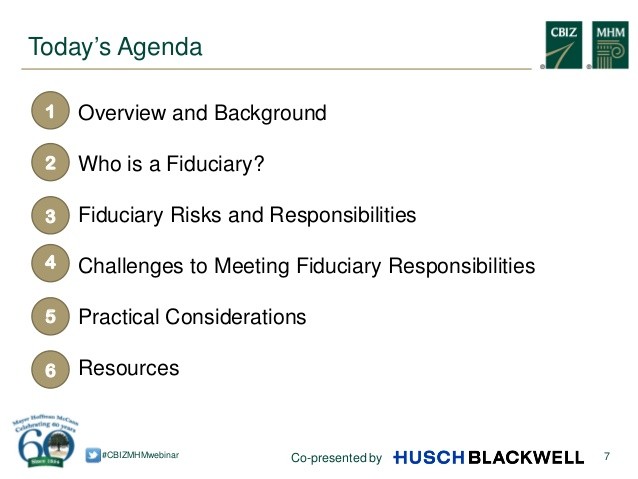Meeting Your Fiduciary Responsibility
Post on: 18 Июнь, 2015 No Comment

So you volunteered to serve on the board of your local charity or other organization and you consider yourself especially lucky to have secured a seat on the investment committee. Perhaps you initially had reservations about your new appointment, but if you have a keen interest in the financial world, some investments of your own, watch CNBC and read the Wall Street Journal. you may feel that you’re qualified. However, while this may be a great way to attend investment committee meetings and receive the latest investment research from the charity’s advisor, this job shouldn’t be taken lightly.
Being a fiduciary comes with a certain level of responsibility. An investment fiduciary is any person who has the legal responsibility for managing somebody else’s money. What this really means is that you have been placed in a position of trust and there may be consequences for betrayal of that trust. In this article, we’ll discuss who is considered a fiduciary and what a fiduciary’s responsibilities entail.
Engaging an advisor who is willing to accept fiduciary responsibility is desirable because investment committee members reduce their liability by delegating some of their responsibilities to an expert. However, hiring an expert does not relieve the committee members of all of their duties. They still have an obligation to prudently select and monitor the activities of the expert; therefore, committee members still must understand what constitutes a fiduciary investment process.
A Fiduciary’s Responsibilities
A fiduciary’s main responsibility is to manage a prudent investment process. A prudent process is not as nebulous as it may sound. A fiduciary demonstrates prudence by the process through which investment decisions are managed. This means fiduciaries must have a basic outline for how they go about their responsibilities. In response to the need for guidance for fiduciaries, the nonprofit Foundation for Fiduciary Studies was established to define the following prudent investment practices:
Step 1: Organize
The process begins with fiduciaries educating themselves on the laws and rules that will apply to their situations. For example, fiduciaries of retirement plans need to understand that the Employees Retirement and Income Security Act (ERISA) is the primary legislation that governs their actions. Once fiduciaries identify their governing rules, they then need to define the roles and responsibilities of all parties involved in the process. If investment service providers are used, then any service agreements should be in writing.
Step 2: Formalize
Formalizing the investment process starts by creating the investment program’s goals and objectives. Fiduciaries should identify factors such as investment horizon. an acceptable level of risk and expected return. By identifying these factors, fiduciaries create the framework for evaluating investment options.
Fiduciaries then need to select appropriate asset classes that will enable them to create a diversified portfolio through some justifiable methodology. Most fiduciaries go about this by employing modern portfolio theory (MPT) because MPT is one of the most accepted methods for creating investment portfolios that target a desired risk/return profile.
Finally, the fiduciary should formalize these steps by creating an investment policy statement, which provides the necessary detail to implement a specific investment strategy. Now the fiduciary is ready to proceed with the implementation of the investment program as identified in the first two steps.
Step 3: Implement
The implementation phase is where specific investments or investment managers are selected to fulfill the requirements detailed in the investment policy statement. A due diligence process must be designed to evaluate potential investments. The due diligence process should identify criteria used to evaluate and filter through the pool of potential investment options.

The implementation phase is usually performed with the assistance of an investment advisor because many fiduciaries lack the skill and/or resources to perform this step. When an advisor is used to assist in the implementation phase, fiduciaries and advisors must communicate to ensure that an agreed upon due diligence process is being used in the selection of investments or managers.
Step 4: Monitor
The final step can be the most time consuming and also the most neglected part of the process. Some fiduciaries do not sense the urgency for monitoring if they got the first three steps correct. Fiduciaries should not neglect any of their responsibilities, because they could be equally liable for negligence in each step.
In order to properly monitor the investment process, fiduciaries must periodically review reports that compare their investments’ performance against the appropriate index, peer group and whether the investment policy statement objectives are being met. Simply monitoring performance statistics is not enough. Fiduciaries must also monitor qualitative data, such as changes in the organizational structure of investment managers used in the portfolio. If the investment decision makers in an organization have left, or if their level of authority has changed, then investors must consider how this information may impact future performance.
In addition to performance reviews, fiduciaries must review expenses incurred in the implementation of the process. Fiduciaries are not only responsible for how funds are invested, but they are also responsible for how funds are spent. Investment fees have a direct impact on performance and fiduciaries must ensure that fees paid for investment management are fair and reasonable.
The Bottom Line
Through proper execution of the prudent investment process outlined in these four steps, trustees and investment committee members can reduce their liability by being confident that they are fulfilling their fiduciary responsibilities. Fiduciaries should embrace their responsibilities and understand that they will not be judged on the returns of their portfolio, but on the prudence employed in the creation of the returns. If fiduciaries get the process right, they should be able to achieve admirable returns for their organizations. In the end, it’s not whether you win or lose, it’s how you play the game.














